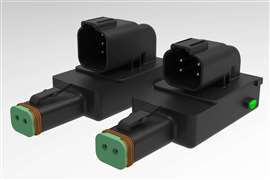Read this article in Français Deutsch Italiano Português Español
ABB E-Mobility amps up the charging experience
14 August 2025
With more than a decade of experience and 50,000 DC fast chargers deployed around the world, electric vehicle (EV) charger manufacturer ABB E-mobility understands that one size does not fit all when it comes to meeting EV charging needs. As such, it provides fast charging solutions from 50 kW on up to 1.2 MW.
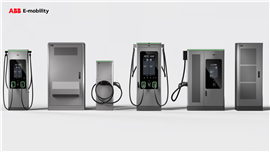 ABB E-mobility EV charging solutions: the MCS1200 Megawatt Charging System, field upgradable A200/300 and ChargeDock dispenser and A400 and C50 Compact Charger. (Photo: ABB E-mobility)
ABB E-mobility EV charging solutions: the MCS1200 Megawatt Charging System, field upgradable A200/300 and ChargeDock dispenser and A400 and C50 Compact Charger. (Photo: ABB E-mobility)
“The entire family in our portfolio is powering vehicles and use cases of all different sizes,” said Brandt Hastings, president of North America and chief commercial officer at ABB E-mobility. “Where we’re most focused on right now is ensuring that for the different use cases, which have different business logic and financial models behind them, [the chargers] are going to make the operator money – that we have the right, reliable charging application for them.”
Serving commercial fleets
This includes having solutions that meet the needs of commercial fleets where vehicles return to a depot overnight as well as those that require available charging en route.
“Depot [charging], maybe you have a single cabinet of power with a number of outlets that are distributed that are giving vehicles a 60-kW charge overnight. It’s plenty if a truck parks for eight hours.
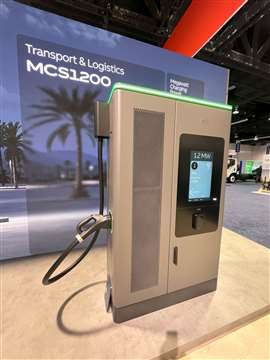 The 1.2-MW MCS1200 Megawatt Charging System enables fast charging of vehicles in transit. (Photo: Becky Schultz)
The 1.2-MW MCS1200 Megawatt Charging System enables fast charging of vehicles in transit. (Photo: Becky Schultz)
“But that truck that’s driving from San Diego to Sacramento is going to need to stop along the way, and the goal is to get that truck back out as quickly as possible to perform its mission. That’s where a 1.2-MW charge would be a significant contributor.”
ABB E-mobility introduced its 1.2-MW MCS1200 Megawatt Charging System specifically for this type of application. It is designed to quickly supply up to 1,200 kW of continuous power from a purpose-built single outlet.
“If you think about the large trucks that need to perform missions of driving from point X to point Y, they need a very fast recharge; there’s 30-minute required breaks for truckers,” Hastings said. “Starting with the user first, which in this case is a commercial fleet, and then coming backwards and saying, ‘Well, how do we design a product that enables that truck to do what it needs to do’ – that was really the genesis behind the 1.2-MW charger.
Reliability and availability
Maintaining charger performance for in-transit charging has been an ongoing industry challenge. “Above all this is this conversation of reliability. Products have to work,” Hastings emphasized.
“We all know that the charging experience over the past few years and even today, it’s not great,” he stated. “One in five charging sessions experiences some sort of issue. You go to a charger and it may be in use or it may not be working and you didn’t know that, and you’re counting on that for critical fuel for your electric vehicle.
“[That lack of] reliability hurts in a couple of different ways: one, it erodes profits, and two, it erodes user trust. So, this is an issue that we’re addressing head on at ABB E-mobility.”
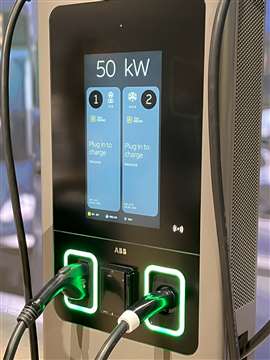 ABB E-mobility has designed the user interface to be highly intuitive for ease of use. (Photo: Becky Schultz)
ABB E-mobility has designed the user interface to be highly intuitive for ease of use. (Photo: Becky Schultz)
The company has vertically integrated its charger development “from the design and the power modules, the user experience and the connectivity to the back end,” Hastings said. This is all done internally “because we know that vertical integration is going to enable better user outcomes.”
Consider the user interface. “When you look at our chargers, the user interface is super intuitive, and that matters even in a [business to business] type of environment, because we want to create charging experiences that are as easy as the digital world we all live in,” Hastings said. “It’s super clear what to do, which enables a successful charge and gets that vehicle back out on the road to do what it needs to do.”
ABB E-mobility is also working to integrate its chargers into customers’ charging management and back-end systems to make them “discoverable,” so drivers can know a charger is available and operational even before they arrive at a charging station or depot.
“We’re looking to remove all of those friction points from the user experience to create more of a digital type of journey for users and operators alike,” Hastings said.
In addition, ABB E-mobility has the ability to monitor its chargers 24/7 and support them remotely through its Asset Management plan, which Hasting said is another key piece to ensuring charger reliability and uptime.
“As an operator or as a user of these networks, we’re focused on ensuring that you know these chargers are going to be available,” he said. “They’re going to be up, they’re going to be running, they’re going to be able to get you back on the road to perform your mission.”
Industry partners
Such focus on meeting the specific needs of fleet customers is why charging service provider Zeem Solutions has been such a loyal and longstanding partner with ABB E-mobility. Virtually all the chargers at Zeem’s LAX charging depot are from ABB E-mobility.
“They designed the charger around us, and I was thrilled,” said Zeem CEO and Founder Paul Gioupis. “That’s why I love ABB. They’re just smart people. They’ve got great brand recognition, but they also know what they’re doing.”
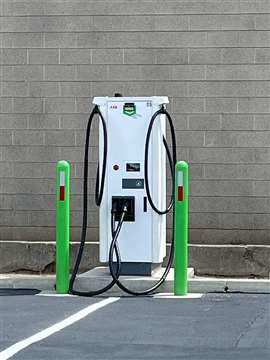 An ABB E-mobility charger at the Zeem Solutions LAX charging depot in Los Angeles, Calif. (Photo: Becky Schultz)
An ABB E-mobility charger at the Zeem Solutions LAX charging depot in Los Angeles, Calif. (Photo: Becky Schultz)
“When you look at Zeem’s business model, they do a fantastic job of providing fleets of all different sizes with reliable, available charging so that those vehicles – whether it’s an Uber or a passenger vehicle, all the way up to a heavy truck that’s fueling supply chains – can perform their missions,” Hastings said. “And it’s all powered by ABB E-mobility technology at the Zeem depot.
“Again, it’s making sure that those Ubers can get out and pick up passengers. It’s making sure that those delivery trucks can deliver their goods, supply chains don’t break and so forth. So, it’s been a really exciting relationship that we’ve developed with them, and I expect it to continue to grow.”
ABB E-mobility also has relationships with OEMs on both the passenger and commercial vehicle side, centered around further fostering EV adoption.
“The reality is unless there is available, reliable charging infrastructure, it is going to get in the way of broader electric vehicle adoption, whether that’s passenger through to heavy commercial,” Hastings pointed out. “So, we see this as a very close-knit relationship. We work very closely with the OEMs as partners on this topic.
“You can find ABB E-mobility equipment at many of these OEMs where we’re doing testing of interoperability and all of that. And so, we see ourselves as partnering very closely to ensure that electric vehicle adoption, in all facets, can continue to scale.”
POWER SOURCING GUIDE
The trusted reference and buyer’s guide for 83 years
The original “desktop search engine,” guiding nearly 10,000 users in more than 90 countries it is the primary reference for specifications and details on all the components that go into engine systems.
Visit Now
STAY CONNECTED




Receive the information you need when you need it through our world-leading magazines, newsletters and daily briefings.
CONNECT WITH THE TEAM











